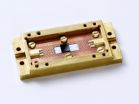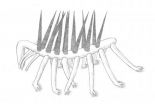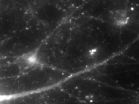(Press-News.org) VIDEO:
Cancer cells advance across a microchip designed to be an obstacle course for cells. The device sheds new light on how cancer cells invade and could be used to test...
Click here for more information.
PROVIDENCE, R.I. [Brown University] — Using a microengineered device that acts as an obstacle course for cells, researchers have shed new light on a cellular metamorphosis thought to play a role in tumor cell invasion throughout the body.
The epithelial-mesenchymal transition (EMT) is a process in which epithelial cells, which tend to stick together within a tissue, change into mesenchymal cells, which can disperse and migrate individually. EMT is a beneficial process in developing embryos, allowing cells to travel throughout the embryo and establish specialized tissues. But recently it has been suggested that EMT might also play a role in cancer metastasis, allowing cancer cells to escape from tumor masses and colonize distant organs.
For this study, published in the journal Nature Materials, the researchers were able to image cancer cells that had undergone EMT as they migrated across a device that mimics the tissue surrounding a tumor.
"People are really interested in how EMT works and how it might be associated with tumor spread, but nobody has been able to see how it happens," said lead author Ian Y. Wong, assistant professor in the Brown School of Engineering and the Center for Biomedical Engineering, who performed the research as a postdoctoral fellow at Massachusetts General Hospital. "We've been able to image these cells in a biomimetic system and carefully measure how they move."
The experiments showed that the cells displayed two modes of motion. A majority plod along together in a collectively advancing group, while a few cells break off from the front, covering larger distances more quickly.
"In the context of cell migration, EMT upgrades cancer cells from an economy model to a fast sports car," Wong said. "Our technology enabled us to track the motion of thousands of 'cars' simultaneously, revealing that many sports cars get stuck in traffic jams with the economy cars, but that some sports cars break out of traffic and make their way aggressively to distant locations."
Armed with an understanding of how EMT cancer cells migrate, the researchers hope they can use this same device for preliminary testing of drugs aimed at inhibiting that migration. The work is part of a larger effort to understand the underpinnings of cancer metastasis, which is responsible for nine out of 10 cancer-related deaths.
'Obstacle course for cells'
To get this new view of how cancer cells move, the researchers borrowed microelectronics processing techniques to pattern miniaturized features on silicon wafers, which were then replicated in a rubber-like plastic called PDMS. The device consists of a small plate, about a half-millimeter square, covered in an array of microscopic pillars. The pillars, each about 10 micrometers in diameter and spaced about 10 micrometers apart, leave just enough space for the cells to weave their way through. Using microscopes and time-lapse photography, the researchers can watch cells as they travel across the plate.
"It's basically an obstacle course for cells," Wong said. "We can track individual cells, and because the size and spacing of these pillars is highly controlled, we can start to do statistical analysis and categorize these cells based on how they move."
For their experiments, the researchers started with a line of benign cancer cells that were epithelial, as identified by specific proteins they express. They then applied a chemical that induced the cells to become malignant and mesenchymal. The transition was confirmed by looking for proteins associated with the mesenchymal cell type. Once all the cells had converted, they were set free on the obstacle course.
The study showed that about 84 percent of the cells stayed together and slowly advanced across the plate. The other 16 percent sped off the front and quickly made it all the way across the device. To the researchers' surprise, they found that the cells that stayed with the group started to once again express the epithelial proteins, indicating that they had reverted back to the epithelial cell type.
"That was a remarkable result," Wong said. "Based on these results, an interesting therapeutic strategy might be to develop drugs that downgrade mesenchymal sports cars back to epithelial economy models in order to keep them stuck in traffic, rather than aggressively invading surrounding tissues."
As for the technology that made these findings possible, the researchers are hopeful that it can be used for further research and drug testing.
"We envision that this technology will be widely applicable for preclinical testing of anti-migration drugs against many different cancer cell lines or patient samples," Wong said.
INFORMATION:
Other authors on the paper are Elisabeth A. Wong (no relation), now a medical student at the Alpert Medical School of Brown University, as well as Sarah Javaid, Sinem Perk, Daniel A. Haber, Mehmet Toner, and Daniel Irimia of Massachusetts General Hospital. The work was supported by the Damon Runyon Cancer Research Foundation (DRG-2065-10), the Howard Hughes Medical Institute and the National Institute of Health under (CA129933, EB002503, CA135601, GM092804).
Note to Editors:
Editors: Brown University has a fiber link television studio available for domestic and international live and taped interviews, and maintains an ISDN line for radio interviews. For more information, call (401) 863-2476.
Microchip reveals how tumor cells transition to invasion
2014-08-17
ELSE PRESS RELEASES FROM THIS DATE:
'Cavity protection effect' helps to conserve quantum information
2014-08-17
The electronics we use for our computers only knows two different states: zero or one. Quantum systems on the other hand can be in different states at once, they can store a superposition of "zero" and "one". This phenomenon could be used to build ultrafast quantum computers, but there are several technological obstacles that have to be overcome first. The biggest problem is that quantum states are quickly destroyed due to interactions with the environment. At TU Wien (Vienna), scientists have now succeeded in using a protection effect to enhance the stability of a particularly ...
FDA-approved drug restores hair in patients with Alopecia Areata
2014-08-17
NEW YORK, NY (August 17, 2014) —Researchers at Columbia University Medical Center (CUMC) have identified the immune cells responsible for destroying hair follicles in people with alopecia areata, a common autoimmune disease that causes hair loss, and have tested an FDA-approved drug that eliminated these immune cells and restored hair growth in a small number of patients.
The results appear in today's online issue of Nature Medicine.
In the paper, the researchers report initial results from an ongoing clinical trial of the drug, which has produced complete hair regrowth ...
Fascinating rhythm: Light pulses illuminate a rare black hole
2014-08-17
The universe has so many black holes that it's impossible to count them all. There may be 100 million of these intriguing astral objects in our galaxy alone. Nearly all black holes fall into one of two classes: big, and colossal. Astronomers know that black holes ranging from about 10 times to 100 times the mass of our sun are the remnants of dying stars, and that supermassive black holes, more than a million times the mass of the sun, inhabit the centers of most galaxies.
But scattered across the universe like oases in a desert are a few apparent black holes of a more ...
A shift in the code: New method reveals hidden genetic landscape
2014-08-17
Cold Spring Harbor, NY – With three billion letters in the human genome, it seems hard to believe that adding a DNA base here or removing a DNA base there could have much of an effect on our health. In fact, such insertions and deletions can dramatically alter biological function, leading to diseases from autism to cancer. Still, it is has been difficult to detect these mutations. Now, a team of scientists at Cold Spring Harbor Laboratory (CSHL) has devised a new way to analyze genome sequences that pinpoints so-called insertion and deletion mutations (known as "indels") ...
New home for an 'evolutionary misfit'
2014-08-17
One of the most bizarre-looking fossils ever found - a worm-like creature with legs, spikes and a head difficult to distinguish from its tail – has found its place in the evolutionary Tree of Life, definitively linking it with a group of modern animals for the first time.
The animal, known as Hallucigenia due to its otherworldly appearance, had been considered an 'evolutionary misfit' as it was not clear how it related to modern animal groups. Researchers from the University of Cambridge have discovered an important link with modern velvet worms, also known as onychophorans, ...
Stem cells reveal how illness-linked genetic variation affects neurons
2014-08-17
VIDEO:
Human neurons firing
Click here for more information.
A genetic variation linked to schizophrenia, bipolar disorder and severe depression wreaks havoc on connections among neurons in the developing brain, a team of researchers reports. The study, led by Guo-li Ming, M.D., Ph.D., and Hongjun Song, Ph.D., of the Johns Hopkins University School of Medicine and described online Aug. 17 in the journal Nature, used stem cells generated from people with and without mental illness ...
New Stanford research sheds light on how children's brains memorize facts
2014-08-17
As children learn basic arithmetic, they gradually switch from solving problems by counting on their fingers to pulling facts from memory. The shift comes more easily for some kids than for others, but no one knows why.
Now, new brain-imaging research gives the first evidence drawn from a longitudinal study to explain how the brain reorganizes itself as children learn math facts. A precisely orchestrated group of brain changes, many involving the memory center known as the hippocampus, are essential to the transformation, according to a study from the Stanford University ...
Suspect gene corrupts neural connections
2014-08-17
Researchers have long suspected that major mental disorders are genetically-rooted diseases of synapses – the connections between neurons. Now, investigators supported in part by the National Institutes of Health have demonstrated in patients' cells how a rare mutation in a suspect gene disrupts the turning on and off of dozens of other genes underlying these connections.
"Our results illustrate how genetic risk, abnormal brain development and synapse dysfunction can corrupt brain circuitry at the cellular level in complex psychiatric disorders," explained Hongjun Song, ...
Stuck in neutral: Brain defect traps schizophrenics in twilight zone
2014-08-17
People with schizophrenia struggle to turn goals into actions because brain structures governing desire and emotion are less active and fail to pass goal-directed messages to cortical regions affecting human decision-making, new research reveals.
Published in Biological Psychiatry, the finding by a University of Sydney research team is the first to illustrate the inability to initiate goal-directed behaviour common in people with schizophrenia.
The finding may explain why people with schizophrenia have difficulty achieving real-world goals such as making friends, completing ...
Virginity pledges for men can lead to sexual confusion -- even after the wedding day
2014-08-17
Bragging of sexual conquests, suggestive jokes and innuendo, and sexual one-upmanship can all be a part of demonstrating one's manhood, especially for young men eager to exert their masculinity.
But how does masculinity manifest itself among young men who have pledged sexual abstinence before marriage? How do they handle sexual temptation, and what sorts of challenges crop up once they're married?
"Sexual purity and pledging abstinence are most commonly thought of as feminine, something girls and young women promise before marriage," said Sarah Diefendorf, a sociology ...









